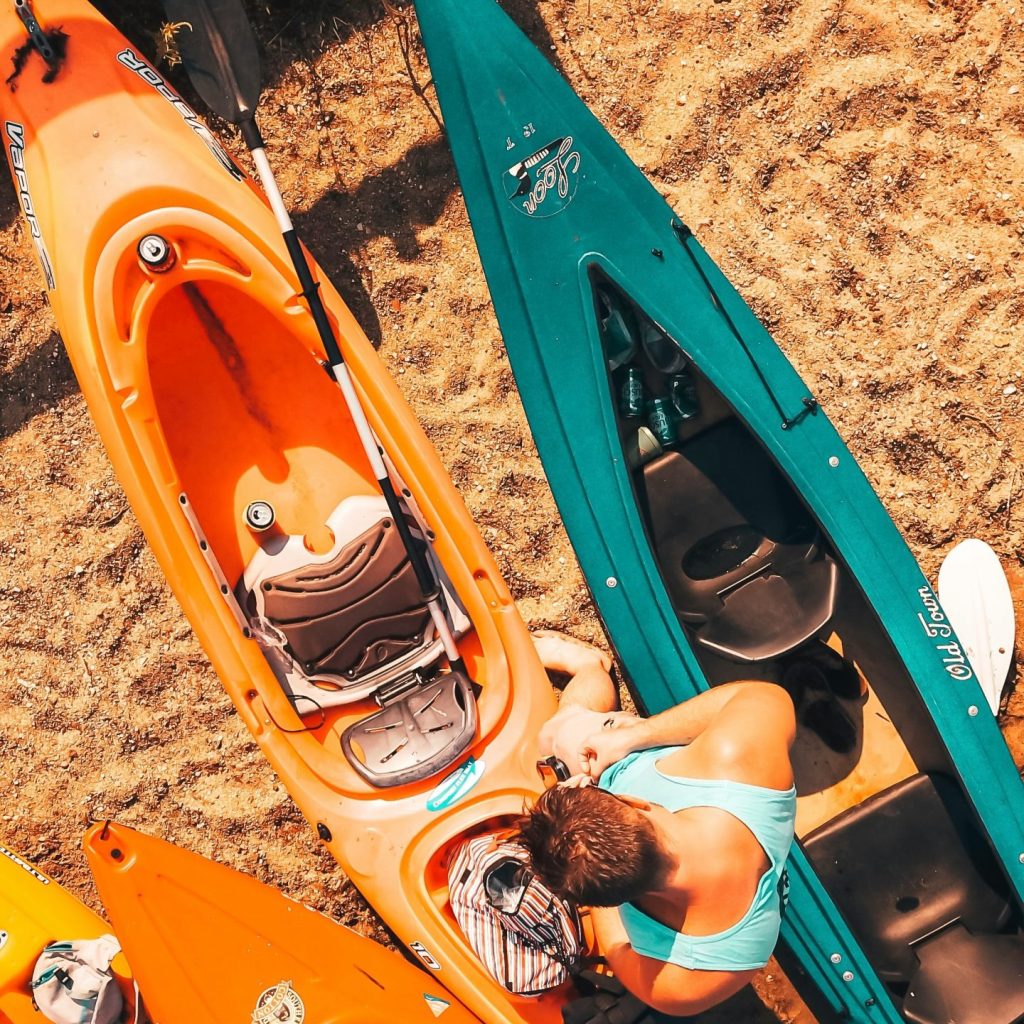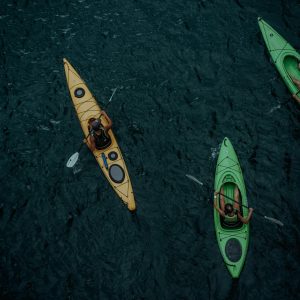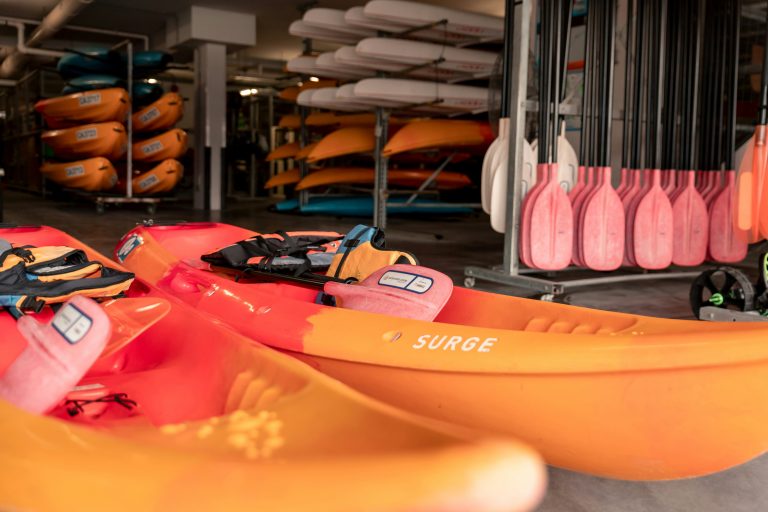Learn how to choose a kayak for beginners with 7 key factors that help you avoid costly mistakes and find the perfect kayak for your paddling goals.

Table of Contents
How to Choose a Kayak
Choosing a kayak for the first time can be overwhelming. With countless styles, materials, and features on the market, it’s easy to feel unsure about what truly matters. This beginner-focused guide outlines seven essential factors to help you choose a kayak that fits your needs, budget, and paddling goals—whether you’re planning to paddle calm lakes, gentle rivers, or open water.
1. Paddling Environment
Understanding where you’ll be kayaking most often is the first step in making the right choice. Kayaks are designed for specific environments, such as calm lakes, slow-moving rivers, coastal waters, or whitewater.
- Recreational kayaks (10–12 feet) are ideal for calm water and beginners. They offer wide, stable hulls for easier control.
- Touring kayaks are longer and narrower, designed for open water, wind, and waves. They offer better tracking and speed, but may feel less stable to new paddlers.
- Whitewater kayaks are compact and highly maneuverable but not recommended for first-time buyers unless specifically training for river rapids.
Choosing a kayak that suits your primary environment will improve performance and overall experience.
2. Body Size and Strength
Physical dimensions and strength play an important role in kayak selection. A kayak that doesn’t fit well can be uncomfortable and difficult to maneuver.
- Weight capacity should be at least 125% of your body weight plus gear. Always check the manufacturer’s recommended capacity.
- Width contributes to both stability and paddling efficiency. Wider kayaks offer more stability but require more effort to paddle.
- Ensure the cockpit or seat area allows enough space for legroom and comfortable posture, especially on longer trips.
3. Kayak Material
Material affects weight, durability, price, and maintenance.
- Rotomolded polyethylene is durable and affordable but heavier. Ideal for beginners who value impact resistance.
- Thermoformed ABS plastic is lighter and offers better UV resistance, balancing durability and cost.
- Composite materials like fiberglass or carbon fiber are lightweight and high-performance, but expensive and less durable for beginners.
For most entry-level paddlers, polyethylene or ABS kayaks offer the best value.
4. Hull Shape and Stability
The shape of the kayak’s hull directly influences stability, tracking, and speed.
- Flat hulls offer strong initial stability, making them suitable for beginners, fishing, or photography.
- Rounded hulls provide smoother movement through the water but may feel less stable at first.
- V-shaped hulls track better and cut through water efficiently but may feel “tippy” for new paddlers.
Most beginner-friendly kayaks feature a shallow V or slightly rounded flat hull for a balance of stability and performance.
5. Cockpit Style and Accessibility
Kayaks come in two main styles: sit-on-top and sit-inside. Each has pros and cons based on comfort, weather, and paddling conditions.
- Sit-on-top kayaks are open and easy to enter/exit. They’re great for warm-weather paddling and are generally more user-friendly.
- Sit-inside kayaks provide more protection from water and wind but may feel confining to some users.
For sit-inside kayaks, cockpit size affects comfort and ease of entry. Larger cockpits are typically better for beginners, while smaller ones offer better water resistance in rough conditions.
6. Storage and Transportation
Practical concerns like storage and transport are often overlooked but critical.
- Shorter kayaks (10–12 feet) are easier to store and transport in standard vehicles.
- Inflatable kayaks are compact and ideal for those with limited space but may sacrifice some performance and durability.
- Consider whether you have access to roof racks, storage sheds, or trailers. The weight of the kayak also affects whether it can be loaded or carried solo.
Planning ahead for how you’ll move and store your kayak can prevent future inconvenience.
7. Budget and Value
Beginner kayaks typically range from $300 to $800, with higher-end models exceeding $2,000. The best approach is to invest in a reliable mid-range option from a reputable brand.
- Avoid ultra-low-cost models from non-specialty stores, as they often compromise on materials and comfort.
- Trusted brands like Perception, Wilderness Systems, and Old Town offer beginner-friendly models with lasting value.
- Used kayaks can be a smart choice if inspected thoroughly—especially around the hull, seat, and attachment points.
Spending wisely ensures better safety, comfort, and long-term satisfaction.
Quick Recap: Beginner Kayak Buying Checklist
- Match your kayak to your main paddling environment.
- Choose a kayak that fits your body size and strength.
- Select the right material based on durability and weight.
- Understand how hull shape affects stability and speed.
- Decide between sit-on-top or sit-inside based on comfort and access.
- Think ahead about how you’ll store and transport the kayak.
- Set a realistic budget and avoid extremely cheap models.
Final Thoughts
Choosing your first kayak is all about finding a boat that matches your skill level, paddling environment, and personal comfort. It’s easy to get overwhelmed by the variety of shapes, materials, and features on the market, but keeping your focus on the essentials can make the process simple and enjoyable.
Start by identifying where you plan to kayak most often—calm lakes, coastal waters, or slow-moving rivers—and choose a model designed specifically for that environment. From there, consider how your body type, strength, and paddling goals will affect your choice. A kayak that’s stable, fits your frame, and meets your storage and transport needs will serve you far better than one built for advanced touring or specialized conditions.
Remember, the best kayak for beginners isn’t necessarily the most expensive or feature-packed—it’s the one that helps you feel confident and safe on the water. Many beginners find that starting with a basic recreational or sit-on-top kayak is more than enough for their first few seasons. As you gain more experience and develop your skills, you’ll naturally learn what features matter most to you—and when the time is right, upgrading will feel like an exciting next step, not a costly mistake.
If you’re still feeling uncertain or want more help narrowing your options, don’t worry. You’re not alone—every experienced paddler was once a beginner, too. To dive deeper into the basics, explore safety tips, gear checklists, and beginner techniques, check out our full guide:
👉 Kayaking for Beginners: Ultimate 2025 Guide to Epic Start
The most important thing is to start. Whether it’s a peaceful paddle on a nearby lake or your first short trip on a gentle river, getting on the water with the right kayak can spark a lifelong love for paddling. Take your time, ask questions, and trust the process—your ideal first kayak is out there waiting.
🔍 Frequently Asked Questions
What is the best type of kayak for beginners?
Recreational sit-on-top or sit-inside kayaks (10–12 feet) are ideal for beginners thanks to their stability, comfort, and ease of use.
Should I choose a sit-on-top or sit-inside kayak?
Sit-on-top kayaks are easier to use and best for warm weather. Sit-inside kayaks offer more protection and may be better in colder or choppy waters.
How much should a beginner spend on a kayak?
Expect to spend around $300–$800 for a quality beginner kayak. Avoid the cheapest options, as they often lack comfort and durability.







